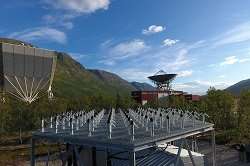Taking near-Earth space research to the next level with Arctic phased array radars

With the unprecedented promise that the EU-supported EISCAT3D radar infrastructure holds for investigation into near-earth space phenomena, system accuracy and efficiency is paramount. The recently closed EISCAT3D_PfP project successfully demonstrated the viability of the initiative, launching it into the implementation phase.
EISCAT3D provides a powerful new research infrastructure, using radar observations to explore how the Earth's atmosphere is coupled to space around the planet, as well as providing wider support to solar system and radio astronomy sciences. Using versatile computer technology, it will also help new areas of research, such as micrometeor measurements and asteroid imaging.
The project's recently completed implementation phase, dubbed EISCAT3D_PfP, has established the necessary approach for EISCAT3D to make its detailed, three-dimensional measurements of the ionised portion of the top of the atmosphere.
The location for the EISCAT3D tool is under a region where the coupling between the atmosphere and space is most direct and dynamic, the night-time auroral zone in the Fenno-Scandinavian Arctic. As project coordinator Dr. Craig Heinselman explains, "When we watch the aurora or measure it with optical instruments, we are seeing the effects of charged particles guided in part by the Earth's magnetic field, as they deposit large amounts of energy and momentum to the top of the neutral atmosphere. While this is impressive to see, it is only part of the story because energy also goes into ionising the atmosphere."
EISCAT3D will allow scientists to see the results of this atmospheric ionisation and to use the ions and electrons as tracers indicating the processes that drive it, such as electric fields. It is hoped that following the phenomena as it unfolds will lead to a better understanding of where the energy goes, how it interacts with the larger system and what impact this has.
The project has been designed with phased array radars. Altering the radar electronics for both transmission and reception, results in them changing their direction very rapidly. If required, its design allows it to look in a different direction every 1/1000 th of a second. This contrasts with the more typical dish-shaped radars, which are only able to look in different directions by using large powerful electric motors to move their heavy antennae hardware.
Additionally, two of the EISCAT3D antennae will be receive-only, meaning that as well as following the rapid movement of the transmitter beam, they will be able to look in 100 different directions at the same time. This enables them to simultaneously see the transmitted signals at all altitudes, not only at a single altitude as is the case with some current operating systems.
One major challenge that the EISCAT3D_PfP project was able to overcome was being able to development a system with sufficient computing capacity to fulfil the design brief. As Dr. Heinselman recalls, "When the design study was conducted it was simply not affordable to provide 100 simultaneous narrow beams on receive, so the initial design supported just seven. Fortunately, advances particularly in field programmable gate array technology, made the 100 beams practical and affordable."
Given the accuracy of the measurements required, another challenge was that of building a system whose internal computer clocks wouldn't generate noise which could overwhelm the signals it seeks to measure. An extremely intricate task given that the radar's receiving signals, when combined, are approximately 20 orders of magnitude (0.000000000000000001 %) smaller than the signal transmitted. Achieving this project aim required not only careful design but also extensive testing on the part of the project team.
EISCAT3D_PfP has now demonstrated the feasibility of the EISCAT3D project goals and launched it into the implementation phase. EISCAT3D's systems are anticipated to be available to scientists by the end of 2021.
Looking to the future Dr. Heinselman says, "As EISCAT3D is a scientific instrument for research it is difficult to say definitively where work will lead, but one very promising area is for the scientific underpinnings predicting Space Weather effects. These effects have, and will certainly continue to have, a growing impact on a society increasingly dependent on space-based technologies."
Provided by CORDIS




















